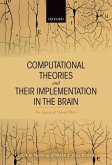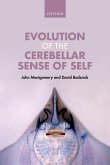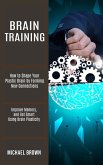Latash
SYNERGY C
Latash
SYNERGY C
- Gebundenes Buch
- Merkliste
- Auf die Merkliste
- Bewerten Bewerten
- Teilen
- Produkt teilen
- Produkterinnerung
- Produkterinnerung
Synergy dicusses a general problem in biology: the lack of an adequate language for formulating biologically specific problems. It describes the recent progress in the control and coordination of human movement. The book begins with a brief history of movement studies and reviews the current central controversies in the area of control of movements with an emphasis on the equilibrium-point hypothesis. An operational definition of synergy is introduced and a method of analysis of synergies is described based on the uncontrolled manifold hypothesis. Further this method is used to characterize…mehr
Andere Kunden interessierten sich auch für
![Dendrites Dendrites]() Dendrites154,99 €
Dendrites154,99 €![Computational Theories and their Implementation in the Brain Computational Theories and their Implementation in the Brain]() Computational Theories and their Implementation in the Brain81,99 €
Computational Theories and their Implementation in the Brain81,99 €![Evolution of the Cerebellar Sense of Self Evolution of the Cerebellar Sense of Self]() John MontgomeryEvolution of the Cerebellar Sense of Self84,99 €
John MontgomeryEvolution of the Cerebellar Sense of Self84,99 €![Rethinking Cognitive Enhancement Rethinking Cognitive Enhancement]() Rethinking Cognitive Enhancement106,99 €
Rethinking Cognitive Enhancement106,99 €![EMOTION EXPLAINED SAS C EMOTION EXPLAINED SAS C]() RollsEMOTION EXPLAINED SAS C95,99 €
RollsEMOTION EXPLAINED SAS C95,99 €![Brain Training Brain Training]() Michael BrownBrain Training16,99 €
Michael BrownBrain Training16,99 €![Brain and Memory Brain and Memory]() James L. McGaugh / Norman M. Weinberger / Gary LynchBrain and Memory111,99 €
James L. McGaugh / Norman M. Weinberger / Gary LynchBrain and Memory111,99 €-
-
-
Synergy dicusses a general problem in biology: the lack of an adequate language for formulating biologically specific problems. It describes the recent progress in the control and coordination of human movement. The book begins with a brief history of movement studies and reviews the current central controversies in the area of control of movements with an emphasis on the equilibrium-point hypothesis. An operational definition of synergy is introduced and a method of analysis of synergies is described based on the uncontrolled manifold hypothesis. Further this method is used to characterize synergies in a variety of tasks including such common motor tasks as standing, pointing, reaching, standing-up, and manipulation of hand-held objects. Applications of this method to movements by persons with neurological disorders, persons with atypical development and healthy elderly persons are illustrated, as well as changes in motor synergies with practice. Possible neurophysiological mechanisms of synergies are also discussed with the focus on such conspicuous structures as the spinal cord, the cerebellum, the basal ganglia, and the cortex of the large hemispheres. A variety of models are discussed based on different computational and neurophysiological principles. Possible applications of the introduced definition of synergies to other areas such as perception and language are discussed.
Produktdetails
- Produktdetails
- Verlag: ACADEMIC
- Seitenzahl: 430
- Erscheinungstermin: 20. März 2008
- Englisch
- Abmessung: 240mm x 161mm x 28mm
- Gewicht: 807g
- ISBN-13: 9780195333169
- ISBN-10: 0195333160
- Artikelnr.: 23573593
- Herstellerkennzeichnung
- Libri GmbH
- Europaallee 1
- 36244 Bad Hersfeld
- gpsr@libri.de
- Verlag: ACADEMIC
- Seitenzahl: 430
- Erscheinungstermin: 20. März 2008
- Englisch
- Abmessung: 240mm x 161mm x 28mm
- Gewicht: 807g
- ISBN-13: 9780195333169
- ISBN-10: 0195333160
- Artikelnr.: 23573593
- Herstellerkennzeichnung
- Libri GmbH
- Europaallee 1
- 36244 Bad Hersfeld
- gpsr@libri.de
* Part I: Building a Definition for Synergy
* 1.1: Synergies and Non-synergies: A Few Examples
* 1.2: Palama's Concept of Synergy
* 1.3: Inanimate "synergies": The Table and the Rusty Bucket
* 1.4: Examples of Biological Synergies
* 1.5: The Definition: Three Components of a Synergy
* Part II: A Brief History of Movement Studies
* 2.1: Ancient Greece and Rome
*
* 2.3: The Century of Frogs, Photography, and Amazing Guesses
* 2.4: The Twentieth Century: Wars of Ideas
* 2.5: Nikolai Alexandrovich Bernstein and Movement Science in the
Soviet Union
* 2.6: History of Synergies and the Problem of Motor Redundancy
* 2.7: Problems with Studying Biological Movement
* Part III: Motor Control and Coordination
* 3.1: Israel Gelfand and Michael Tsetlin
* 3.2: Structural Units and the Principle of Minimal Interaction
* 3.3: Motor control: Programs and Internal Models
* Digress on #1: The Muscle: Slow and Visco-elastic
* Digression #2: Neural pathways: Long and Slow
* Digression #3: Sensors: Confusing and Unreliable
* Digression #4: Adaptation to Force Fields and after-effects
* Digression #5: Brain Imaging Techniques: What do they Image?
* 3.4: The Equilibrium-point hypothesis
* 3.4.1: Experimental Foundations of the Equilibrium-point hypothesis
* Digression #6: Reflexes and non-reflexes
* 3.4.3: Three basic trajectories within the equilibrium- point
hypothesis
* 3.4.4: Equilibrium-point control of multi-muscle systems
* 3.4.5.: The mass-spring analogy and other misconceptions
* Part IV: Motor Variability - a Window into Synergies
* 4.1: The Uncontrolled Manifold Hypothesis
* 4.2: Modes as Elemental Variables
* 4.2.1.: Force Modes
* Digression #7: Digit Interaction and its Indices
* 4.2.2.: Muscle Modes
* Digression #8: Electromyography
* 4.2.3.: Experimental Identification of the Jacobian
* 4.3: Stability, Variability, and within-a-trial Analysis of Synergies
* 4.4: Other Computational Tools to Study Synergies
* 4.4.1.: Principal Component Analysis and Uncontrolled Manifold
* 4.4.2.: Analysis of Surrogate Data Sets
* 4.5: Timing Synergies: Do they exist?
* Part V: Zoo of Motor Synergies
* 5.1: Kinematic synergies
* 5.1.1.: Postural Synergies in Standing
* 5.1.2.: Sit-to-Stand Task
* 5.1.3.: Reaching
* Digression #9: Optimization
* 5.1.4.: Reaching in a Changing Force Field
* 5.1.5.: Multi-Joint Pointing
* 5.1.6.: Quick-Draw Pistol Shooting
* 5.2: Kinetic synergies
* 5.3: Multi-Digit Synergies
* 5.3.1.: Force and Moment Stabilization during Multi-Finger Pressing
* 5.3.2.: The Role of Timing Errors
* 5.3.3.: Emergence and Disappearance of Synergies
* 5.3.4.: Anticipatory Synergy Adjustments and Purposeful
Destabilization of Performance
* 5.4: Prehensile Synergies
* 5.4.1.: Hierarchical Control of Prehension
* 5.4.2.: Principle of Superposition
* 5.4.3.: Adjustments of Synergies: Chain Effects
* 5.4.4.: Hierarchies of Synergies
* 5.5: Multi-muscle Synergies
* 5.5.1.: Anticipatory Postural Adustments
* 5.5.2.: Making a Step
* 5.5.3.: Multi-Muscle Syndergies in Hand Force Production
* Part VI: Atypical, Suboptimal, and Changing Synergies
* 6.1: Is there a "normal synergy"?
* 6.2: Principle of Indeterminicity in Movement Studies
* 6.3: Plasticity in the Central Nervous System
* Digression #10: Transcranial Magnetic Stimulation
* 6.4: Changes in Synergies with Age
* 6.4.1.: Effects of Age on Muscles and Neurons
* 6.4.2.: Effects of Age on Motor Coordination
* 6.5: Synergies in Persons with Down syndrome
* 6.5.1.: Movements in Persons with Down syndrome
* 6.5.2.: Multi-finger Coordination in Down syndrome
* 6.5.3.: Effects of Practice on Movement in Down syndrome
* 6.5.4.: Relation of Unusual Synergies to Changes in the Cerebellum
* 6.6: Synergies after Stroke
* 6.7: Learning Movement Synergies
* 6.7.1.: Traditional Views on Motor Learning
* 6.7.2.: What can happen with a Synergy with Practice?
* 6.7.3.: Practicing Kinematic Tasks
* 6.7.4.: Practicing Kinetic Tasks
* 6.7.5.: Plastic Changes with Learning a Synergy
* Part VII: Neurophysiological Mechanisms of Synergies
* 7.1: Neurophysiological Structures and the Motor Function
* Digression #11: What is localized in Neural Structures?
* 7.2: Synergies in the Spinal Cord
* 7.3: Synergies and the Cerebellum
* 7.4: Synergies and the Basal Ganglia
* 7.5: Synergies and the Cortex of the Large Hemispheres
* 7.5.1.: TMS and the equilibrium-point hypothesis
* 7.5.2.: Studies of Neuronal Populations
* Part VIII: Models and Beyond Motor Synergies
* 8.1: Synergies and the Control Theory
* 8.1.1: Control: Basic Notions
* 8.1.2.: Open-loop and Closed-loop (feed-forward and feedback) Control
* 8.1.3.: A Simple Scheme of Synergic Control of a Multi-joint Movement
* 8.1.4.: Optimal Control and Synergies
* 8.2: Synergies and Neural Networks
* 8.3: Synergies Without Feedback
* 8.3.1.: Do Synergies Improve Accuracy?
* 8.3.2.: A Feed-forward Model with Separate Specification of Good and
Bad Ariability
* 8.4: Synergies and the Equilibrium-point Hypothesis
* 8.5: Sensory Synergies
* 8.5.1.: Sensory synergies in Neurological Disorders
* Digression #12: Sensory and Motor Effects of Muscle Vibration
* 8.5.2.: Sensory-motor Interactions
* 8.5.3.: Sensory Synergies in Vertical Posture
* 8.5.4.: Multi-sensory Mechanisms
* 8.6: Language as a Synergy
* 8.7: Concluding Comments: What next?
* 1.1: Synergies and Non-synergies: A Few Examples
* 1.2: Palama's Concept of Synergy
* 1.3: Inanimate "synergies": The Table and the Rusty Bucket
* 1.4: Examples of Biological Synergies
* 1.5: The Definition: Three Components of a Synergy
* Part II: A Brief History of Movement Studies
* 2.1: Ancient Greece and Rome
*
* 2.3: The Century of Frogs, Photography, and Amazing Guesses
* 2.4: The Twentieth Century: Wars of Ideas
* 2.5: Nikolai Alexandrovich Bernstein and Movement Science in the
Soviet Union
* 2.6: History of Synergies and the Problem of Motor Redundancy
* 2.7: Problems with Studying Biological Movement
* Part III: Motor Control and Coordination
* 3.1: Israel Gelfand and Michael Tsetlin
* 3.2: Structural Units and the Principle of Minimal Interaction
* 3.3: Motor control: Programs and Internal Models
* Digress on #1: The Muscle: Slow and Visco-elastic
* Digression #2: Neural pathways: Long and Slow
* Digression #3: Sensors: Confusing and Unreliable
* Digression #4: Adaptation to Force Fields and after-effects
* Digression #5: Brain Imaging Techniques: What do they Image?
* 3.4: The Equilibrium-point hypothesis
* 3.4.1: Experimental Foundations of the Equilibrium-point hypothesis
* Digression #6: Reflexes and non-reflexes
* 3.4.3: Three basic trajectories within the equilibrium- point
hypothesis
* 3.4.4: Equilibrium-point control of multi-muscle systems
* 3.4.5.: The mass-spring analogy and other misconceptions
* Part IV: Motor Variability - a Window into Synergies
* 4.1: The Uncontrolled Manifold Hypothesis
* 4.2: Modes as Elemental Variables
* 4.2.1.: Force Modes
* Digression #7: Digit Interaction and its Indices
* 4.2.2.: Muscle Modes
* Digression #8: Electromyography
* 4.2.3.: Experimental Identification of the Jacobian
* 4.3: Stability, Variability, and within-a-trial Analysis of Synergies
* 4.4: Other Computational Tools to Study Synergies
* 4.4.1.: Principal Component Analysis and Uncontrolled Manifold
* 4.4.2.: Analysis of Surrogate Data Sets
* 4.5: Timing Synergies: Do they exist?
* Part V: Zoo of Motor Synergies
* 5.1: Kinematic synergies
* 5.1.1.: Postural Synergies in Standing
* 5.1.2.: Sit-to-Stand Task
* 5.1.3.: Reaching
* Digression #9: Optimization
* 5.1.4.: Reaching in a Changing Force Field
* 5.1.5.: Multi-Joint Pointing
* 5.1.6.: Quick-Draw Pistol Shooting
* 5.2: Kinetic synergies
* 5.3: Multi-Digit Synergies
* 5.3.1.: Force and Moment Stabilization during Multi-Finger Pressing
* 5.3.2.: The Role of Timing Errors
* 5.3.3.: Emergence and Disappearance of Synergies
* 5.3.4.: Anticipatory Synergy Adjustments and Purposeful
Destabilization of Performance
* 5.4: Prehensile Synergies
* 5.4.1.: Hierarchical Control of Prehension
* 5.4.2.: Principle of Superposition
* 5.4.3.: Adjustments of Synergies: Chain Effects
* 5.4.4.: Hierarchies of Synergies
* 5.5: Multi-muscle Synergies
* 5.5.1.: Anticipatory Postural Adustments
* 5.5.2.: Making a Step
* 5.5.3.: Multi-Muscle Syndergies in Hand Force Production
* Part VI: Atypical, Suboptimal, and Changing Synergies
* 6.1: Is there a "normal synergy"?
* 6.2: Principle of Indeterminicity in Movement Studies
* 6.3: Plasticity in the Central Nervous System
* Digression #10: Transcranial Magnetic Stimulation
* 6.4: Changes in Synergies with Age
* 6.4.1.: Effects of Age on Muscles and Neurons
* 6.4.2.: Effects of Age on Motor Coordination
* 6.5: Synergies in Persons with Down syndrome
* 6.5.1.: Movements in Persons with Down syndrome
* 6.5.2.: Multi-finger Coordination in Down syndrome
* 6.5.3.: Effects of Practice on Movement in Down syndrome
* 6.5.4.: Relation of Unusual Synergies to Changes in the Cerebellum
* 6.6: Synergies after Stroke
* 6.7: Learning Movement Synergies
* 6.7.1.: Traditional Views on Motor Learning
* 6.7.2.: What can happen with a Synergy with Practice?
* 6.7.3.: Practicing Kinematic Tasks
* 6.7.4.: Practicing Kinetic Tasks
* 6.7.5.: Plastic Changes with Learning a Synergy
* Part VII: Neurophysiological Mechanisms of Synergies
* 7.1: Neurophysiological Structures and the Motor Function
* Digression #11: What is localized in Neural Structures?
* 7.2: Synergies in the Spinal Cord
* 7.3: Synergies and the Cerebellum
* 7.4: Synergies and the Basal Ganglia
* 7.5: Synergies and the Cortex of the Large Hemispheres
* 7.5.1.: TMS and the equilibrium-point hypothesis
* 7.5.2.: Studies of Neuronal Populations
* Part VIII: Models and Beyond Motor Synergies
* 8.1: Synergies and the Control Theory
* 8.1.1: Control: Basic Notions
* 8.1.2.: Open-loop and Closed-loop (feed-forward and feedback) Control
* 8.1.3.: A Simple Scheme of Synergic Control of a Multi-joint Movement
* 8.1.4.: Optimal Control and Synergies
* 8.2: Synergies and Neural Networks
* 8.3: Synergies Without Feedback
* 8.3.1.: Do Synergies Improve Accuracy?
* 8.3.2.: A Feed-forward Model with Separate Specification of Good and
Bad Ariability
* 8.4: Synergies and the Equilibrium-point Hypothesis
* 8.5: Sensory Synergies
* 8.5.1.: Sensory synergies in Neurological Disorders
* Digression #12: Sensory and Motor Effects of Muscle Vibration
* 8.5.2.: Sensory-motor Interactions
* 8.5.3.: Sensory Synergies in Vertical Posture
* 8.5.4.: Multi-sensory Mechanisms
* 8.6: Language as a Synergy
* 8.7: Concluding Comments: What next?
* Part I: Building a Definition for Synergy
* 1.1: Synergies and Non-synergies: A Few Examples
* 1.2: Palama's Concept of Synergy
* 1.3: Inanimate "synergies": The Table and the Rusty Bucket
* 1.4: Examples of Biological Synergies
* 1.5: The Definition: Three Components of a Synergy
* Part II: A Brief History of Movement Studies
* 2.1: Ancient Greece and Rome
*
* 2.3: The Century of Frogs, Photography, and Amazing Guesses
* 2.4: The Twentieth Century: Wars of Ideas
* 2.5: Nikolai Alexandrovich Bernstein and Movement Science in the
Soviet Union
* 2.6: History of Synergies and the Problem of Motor Redundancy
* 2.7: Problems with Studying Biological Movement
* Part III: Motor Control and Coordination
* 3.1: Israel Gelfand and Michael Tsetlin
* 3.2: Structural Units and the Principle of Minimal Interaction
* 3.3: Motor control: Programs and Internal Models
* Digress on #1: The Muscle: Slow and Visco-elastic
* Digression #2: Neural pathways: Long and Slow
* Digression #3: Sensors: Confusing and Unreliable
* Digression #4: Adaptation to Force Fields and after-effects
* Digression #5: Brain Imaging Techniques: What do they Image?
* 3.4: The Equilibrium-point hypothesis
* 3.4.1: Experimental Foundations of the Equilibrium-point hypothesis
* Digression #6: Reflexes and non-reflexes
* 3.4.3: Three basic trajectories within the equilibrium- point
hypothesis
* 3.4.4: Equilibrium-point control of multi-muscle systems
* 3.4.5.: The mass-spring analogy and other misconceptions
* Part IV: Motor Variability - a Window into Synergies
* 4.1: The Uncontrolled Manifold Hypothesis
* 4.2: Modes as Elemental Variables
* 4.2.1.: Force Modes
* Digression #7: Digit Interaction and its Indices
* 4.2.2.: Muscle Modes
* Digression #8: Electromyography
* 4.2.3.: Experimental Identification of the Jacobian
* 4.3: Stability, Variability, and within-a-trial Analysis of Synergies
* 4.4: Other Computational Tools to Study Synergies
* 4.4.1.: Principal Component Analysis and Uncontrolled Manifold
* 4.4.2.: Analysis of Surrogate Data Sets
* 4.5: Timing Synergies: Do they exist?
* Part V: Zoo of Motor Synergies
* 5.1: Kinematic synergies
* 5.1.1.: Postural Synergies in Standing
* 5.1.2.: Sit-to-Stand Task
* 5.1.3.: Reaching
* Digression #9: Optimization
* 5.1.4.: Reaching in a Changing Force Field
* 5.1.5.: Multi-Joint Pointing
* 5.1.6.: Quick-Draw Pistol Shooting
* 5.2: Kinetic synergies
* 5.3: Multi-Digit Synergies
* 5.3.1.: Force and Moment Stabilization during Multi-Finger Pressing
* 5.3.2.: The Role of Timing Errors
* 5.3.3.: Emergence and Disappearance of Synergies
* 5.3.4.: Anticipatory Synergy Adjustments and Purposeful
Destabilization of Performance
* 5.4: Prehensile Synergies
* 5.4.1.: Hierarchical Control of Prehension
* 5.4.2.: Principle of Superposition
* 5.4.3.: Adjustments of Synergies: Chain Effects
* 5.4.4.: Hierarchies of Synergies
* 5.5: Multi-muscle Synergies
* 5.5.1.: Anticipatory Postural Adustments
* 5.5.2.: Making a Step
* 5.5.3.: Multi-Muscle Syndergies in Hand Force Production
* Part VI: Atypical, Suboptimal, and Changing Synergies
* 6.1: Is there a "normal synergy"?
* 6.2: Principle of Indeterminicity in Movement Studies
* 6.3: Plasticity in the Central Nervous System
* Digression #10: Transcranial Magnetic Stimulation
* 6.4: Changes in Synergies with Age
* 6.4.1.: Effects of Age on Muscles and Neurons
* 6.4.2.: Effects of Age on Motor Coordination
* 6.5: Synergies in Persons with Down syndrome
* 6.5.1.: Movements in Persons with Down syndrome
* 6.5.2.: Multi-finger Coordination in Down syndrome
* 6.5.3.: Effects of Practice on Movement in Down syndrome
* 6.5.4.: Relation of Unusual Synergies to Changes in the Cerebellum
* 6.6: Synergies after Stroke
* 6.7: Learning Movement Synergies
* 6.7.1.: Traditional Views on Motor Learning
* 6.7.2.: What can happen with a Synergy with Practice?
* 6.7.3.: Practicing Kinematic Tasks
* 6.7.4.: Practicing Kinetic Tasks
* 6.7.5.: Plastic Changes with Learning a Synergy
* Part VII: Neurophysiological Mechanisms of Synergies
* 7.1: Neurophysiological Structures and the Motor Function
* Digression #11: What is localized in Neural Structures?
* 7.2: Synergies in the Spinal Cord
* 7.3: Synergies and the Cerebellum
* 7.4: Synergies and the Basal Ganglia
* 7.5: Synergies and the Cortex of the Large Hemispheres
* 7.5.1.: TMS and the equilibrium-point hypothesis
* 7.5.2.: Studies of Neuronal Populations
* Part VIII: Models and Beyond Motor Synergies
* 8.1: Synergies and the Control Theory
* 8.1.1: Control: Basic Notions
* 8.1.2.: Open-loop and Closed-loop (feed-forward and feedback) Control
* 8.1.3.: A Simple Scheme of Synergic Control of a Multi-joint Movement
* 8.1.4.: Optimal Control and Synergies
* 8.2: Synergies and Neural Networks
* 8.3: Synergies Without Feedback
* 8.3.1.: Do Synergies Improve Accuracy?
* 8.3.2.: A Feed-forward Model with Separate Specification of Good and
Bad Ariability
* 8.4: Synergies and the Equilibrium-point Hypothesis
* 8.5: Sensory Synergies
* 8.5.1.: Sensory synergies in Neurological Disorders
* Digression #12: Sensory and Motor Effects of Muscle Vibration
* 8.5.2.: Sensory-motor Interactions
* 8.5.3.: Sensory Synergies in Vertical Posture
* 8.5.4.: Multi-sensory Mechanisms
* 8.6: Language as a Synergy
* 8.7: Concluding Comments: What next?
* 1.1: Synergies and Non-synergies: A Few Examples
* 1.2: Palama's Concept of Synergy
* 1.3: Inanimate "synergies": The Table and the Rusty Bucket
* 1.4: Examples of Biological Synergies
* 1.5: The Definition: Three Components of a Synergy
* Part II: A Brief History of Movement Studies
* 2.1: Ancient Greece and Rome
*
* 2.3: The Century of Frogs, Photography, and Amazing Guesses
* 2.4: The Twentieth Century: Wars of Ideas
* 2.5: Nikolai Alexandrovich Bernstein and Movement Science in the
Soviet Union
* 2.6: History of Synergies and the Problem of Motor Redundancy
* 2.7: Problems with Studying Biological Movement
* Part III: Motor Control and Coordination
* 3.1: Israel Gelfand and Michael Tsetlin
* 3.2: Structural Units and the Principle of Minimal Interaction
* 3.3: Motor control: Programs and Internal Models
* Digress on #1: The Muscle: Slow and Visco-elastic
* Digression #2: Neural pathways: Long and Slow
* Digression #3: Sensors: Confusing and Unreliable
* Digression #4: Adaptation to Force Fields and after-effects
* Digression #5: Brain Imaging Techniques: What do they Image?
* 3.4: The Equilibrium-point hypothesis
* 3.4.1: Experimental Foundations of the Equilibrium-point hypothesis
* Digression #6: Reflexes and non-reflexes
* 3.4.3: Three basic trajectories within the equilibrium- point
hypothesis
* 3.4.4: Equilibrium-point control of multi-muscle systems
* 3.4.5.: The mass-spring analogy and other misconceptions
* Part IV: Motor Variability - a Window into Synergies
* 4.1: The Uncontrolled Manifold Hypothesis
* 4.2: Modes as Elemental Variables
* 4.2.1.: Force Modes
* Digression #7: Digit Interaction and its Indices
* 4.2.2.: Muscle Modes
* Digression #8: Electromyography
* 4.2.3.: Experimental Identification of the Jacobian
* 4.3: Stability, Variability, and within-a-trial Analysis of Synergies
* 4.4: Other Computational Tools to Study Synergies
* 4.4.1.: Principal Component Analysis and Uncontrolled Manifold
* 4.4.2.: Analysis of Surrogate Data Sets
* 4.5: Timing Synergies: Do they exist?
* Part V: Zoo of Motor Synergies
* 5.1: Kinematic synergies
* 5.1.1.: Postural Synergies in Standing
* 5.1.2.: Sit-to-Stand Task
* 5.1.3.: Reaching
* Digression #9: Optimization
* 5.1.4.: Reaching in a Changing Force Field
* 5.1.5.: Multi-Joint Pointing
* 5.1.6.: Quick-Draw Pistol Shooting
* 5.2: Kinetic synergies
* 5.3: Multi-Digit Synergies
* 5.3.1.: Force and Moment Stabilization during Multi-Finger Pressing
* 5.3.2.: The Role of Timing Errors
* 5.3.3.: Emergence and Disappearance of Synergies
* 5.3.4.: Anticipatory Synergy Adjustments and Purposeful
Destabilization of Performance
* 5.4: Prehensile Synergies
* 5.4.1.: Hierarchical Control of Prehension
* 5.4.2.: Principle of Superposition
* 5.4.3.: Adjustments of Synergies: Chain Effects
* 5.4.4.: Hierarchies of Synergies
* 5.5: Multi-muscle Synergies
* 5.5.1.: Anticipatory Postural Adustments
* 5.5.2.: Making a Step
* 5.5.3.: Multi-Muscle Syndergies in Hand Force Production
* Part VI: Atypical, Suboptimal, and Changing Synergies
* 6.1: Is there a "normal synergy"?
* 6.2: Principle of Indeterminicity in Movement Studies
* 6.3: Plasticity in the Central Nervous System
* Digression #10: Transcranial Magnetic Stimulation
* 6.4: Changes in Synergies with Age
* 6.4.1.: Effects of Age on Muscles and Neurons
* 6.4.2.: Effects of Age on Motor Coordination
* 6.5: Synergies in Persons with Down syndrome
* 6.5.1.: Movements in Persons with Down syndrome
* 6.5.2.: Multi-finger Coordination in Down syndrome
* 6.5.3.: Effects of Practice on Movement in Down syndrome
* 6.5.4.: Relation of Unusual Synergies to Changes in the Cerebellum
* 6.6: Synergies after Stroke
* 6.7: Learning Movement Synergies
* 6.7.1.: Traditional Views on Motor Learning
* 6.7.2.: What can happen with a Synergy with Practice?
* 6.7.3.: Practicing Kinematic Tasks
* 6.7.4.: Practicing Kinetic Tasks
* 6.7.5.: Plastic Changes with Learning a Synergy
* Part VII: Neurophysiological Mechanisms of Synergies
* 7.1: Neurophysiological Structures and the Motor Function
* Digression #11: What is localized in Neural Structures?
* 7.2: Synergies in the Spinal Cord
* 7.3: Synergies and the Cerebellum
* 7.4: Synergies and the Basal Ganglia
* 7.5: Synergies and the Cortex of the Large Hemispheres
* 7.5.1.: TMS and the equilibrium-point hypothesis
* 7.5.2.: Studies of Neuronal Populations
* Part VIII: Models and Beyond Motor Synergies
* 8.1: Synergies and the Control Theory
* 8.1.1: Control: Basic Notions
* 8.1.2.: Open-loop and Closed-loop (feed-forward and feedback) Control
* 8.1.3.: A Simple Scheme of Synergic Control of a Multi-joint Movement
* 8.1.4.: Optimal Control and Synergies
* 8.2: Synergies and Neural Networks
* 8.3: Synergies Without Feedback
* 8.3.1.: Do Synergies Improve Accuracy?
* 8.3.2.: A Feed-forward Model with Separate Specification of Good and
Bad Ariability
* 8.4: Synergies and the Equilibrium-point Hypothesis
* 8.5: Sensory Synergies
* 8.5.1.: Sensory synergies in Neurological Disorders
* Digression #12: Sensory and Motor Effects of Muscle Vibration
* 8.5.2.: Sensory-motor Interactions
* 8.5.3.: Sensory Synergies in Vertical Posture
* 8.5.4.: Multi-sensory Mechanisms
* 8.6: Language as a Synergy
* 8.7: Concluding Comments: What next?









